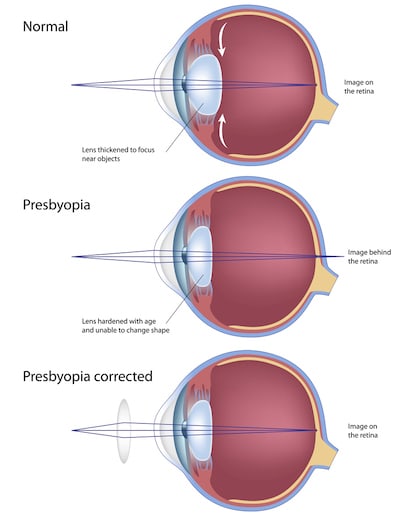What is Presbyopia? | Sandy Springs, Chastain, Buckhead
Presbyopia: Understanding, Causes, Prevention, and Treatment
Presbyopia is a common age-related vision condition that affects people typically around the age of 40 and older. It is characterized by the gradual loss of the eye’s ability to focus on close-up objects, making it difficult to read, thread a needle, or perform other tasks that require near vision.
What is Presbyopia?
Presbyopia, often referred to as “age-related farsightedness,” is a natural part of the aging process that affects nearly everyone at some point in their lives. It occurs due to changes in the eye’s crystalline lens and its surrounding muscles, which play a crucial role in focusing on objects at different distances.
 Causes of Presbyopia:
Causes of Presbyopia:
Age: The primary cause of presbyopia is aging. As people grow older, the lens within the eye becomes less flexible, making it harder to adjust and focus on close-up objects.
Genetics: Family history can influence the onset of presbyopia. If your parents developed presbyopia early in life, you may be more likely to do so as well.
Preventive Measures for Presbyopia:
While it’s impossible to completely prevent presbyopia, certain lifestyle choices and eye care practices can help delay its onset and manage its effects:
- Regular Eye Exams: Schedule regular eye exams with an optometrist or ophthalmologist, especially after the age of 40. Early detection can lead to better management.
- Healthy Diet: Consume a balanced diet rich in vitamins and antioxidants, which may support overall eye health.
- Avoid Smoking: Smoking is linked to various eye conditions, including cataracts and age-related macular degeneration. Quitting or not smoking can help maintain eye health.
- Proper Lighting: Ensure adequate lighting when reading or working on tasks that require close-up vision. Insufficient lighting can strain the eyes.
- Eye Protection: Wear protective eyewear when engaging in activities that pose a risk to eye health, such as playing sports or working with hazardous materials.
- Reduce Screen Time: Limit screen time and use the 20-20-20 rule: every 20 minutes, take a 20-second break and focus on something at least 20 feet away.
Treatment Options for Presbyopia:
Presbyopia is a common vision problem, and several effective treatment options are available to address its symptoms:
- Reading Glasses: One of the simplest and most cost-effective solutions is wearing reading glasses, which provide magnification for close-up tasks.
- Bifocal or Multifocal Lenses: These specialized eyeglass lenses have different prescription strengths in various areas to address both near and distance vision.
- Progressive Lenses: Similar to bifocals but without visible lines, progressive lenses provide a seamless transition from near to far vision.
- Contact Lenses: Multifocal contact lenses are available for those who prefer not to wear glasses.
- Refractive Surgery: Surgical options like LASIK or PRK can correct presbyopia by reshaping the cornea, but these procedures may not be suitable for everyone.
- Lens Replacement Surgery: Intraocular lens (IOL) implantation is a surgical procedure where the eye’s natural lens is replaced with an artificial lens that can correct presbyopia.

Statistics on Presbyopia:
- According to the World Health Organization (WHO), presbyopia affects over 1.3 billion people worldwide, making it one of the most common vision conditions.
- In the United States, it is estimated that more than 120 million people experience presbyopia.
- The onset of presbyopia typically occurs between the ages of 40 and 50, and the condition continues to progress with age.
- A study published in JAMA Ophthalmology found that the prevalence of presbyopia increases with age, affecting nearly 65% of those aged 45 to 54, and nearly 90% of those aged 65 to 74.
Presbyopia – Sandy Springs, Chastain Park, Dunwoody and Buckhead
Presbyopia is a widespread vision problem that accompanies the natural aging process. While it cannot be entirely prevented, early detection and appropriate corrective measures can significantly improve the quality of life for individuals dealing with presbyopia. Regular eye examinations, healthy lifestyle choices, and the use of corrective eyewear or surgical options are key to managing and addressing this common age-related vision impairment. Vision Source Insight Eyecare is a family friendly Optometry Practice that can provide comprehensive eye exams for the entire family and a broad selection of fashion forward eyewear. Call for your appointment today. (404) 250-1680.

